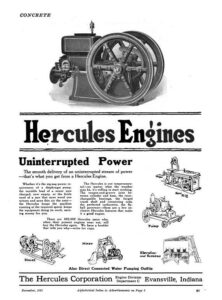
Trailer load of John Deere hit and miss engines at the July 2009 Denton, NC SouthEast Old Thresher’s Reunion.
When I go to old engine shows or when people stop by while I am tinkering with my engines in the driveway, they mostly want to know what they were for. Without passing too much judgment on what people know or don’t know, I suspect most I meet are not very familiar with many of the statistics and facts regarding conditions in America in the early 20th century. Life now – even life back in the 1950s – bears little resemblance to those times. If you think about it, life in 1900 had far more in common with life in 1800 than it does to life in 2000. Horses were still the primary means of personal transportation, and were still common even in commercial transportation.
My oldest engines were built in 1918 and are real bits of history. It is hard now for most people to imagine that during that time, WWI was being fought with American GIs already on the Western Front. Woodrow Wilson was President, and the Panama Canal had only been open for about 4 years. The population in the United States was just 103 million in 1918, that also being the only year in the 20th Century that our population decreased. The entire federal budget was 12.68 billion and a first class postage stamp cost 3 cents.
Electricity would not be common in rural areas for better than 20 years and mechanical refrigeration was an industrial process, not a household necessity. We think nothing of it today. Water just comes out the faucet. Tractors till the land and refrigeration is not simply a luxury in any home, it is a standard amenity in all homes, taken mostly for granted until a hurricane comes along and you have no power for a week. Then you have to eat everything before it goes bad. That’s when you start to recognize that your life would be very difficult without electricity.
I’m not sure what most of these 1-1/2 horsepower engines cost back then but it was probably somewhere around $30. Keep in mind that the average annual income in 1918 was around $1,500. Sears and Roebuck sold their 1-1/2 horsepower Economy engines for $29.95 in 1918, so it is probably fair to assume most competitors were similarly priced. I don’t know how much it cost to maintain a horse for a year, but it was probably hard to use a horse to do all the things these engines could do. I also suspect gasoline at 8 cents per gallon was cheaper than maintaining horses, and you don’t have to feed engines when they’re not working.
Why was the relatively new internal combustion engine the power source of choice when steam power had been around for over 100 years and was quite solid and reliable? Two reasons: economy and convenience. Steam engines were more expensive, and a steam engine of comparable horsepower needed a boiler, was bigger and was a lot more difficult to move from location to location. Also, before a steam engine could be used for work, steam had to be raised to operating pressure, the engine had to be warmed up and made ready for work. Small gas engines were much lighter, could easily be moved from location to location to be belted up to different machinery, and could be started quickly and placed in service without fuss. They also consumed considerably less fuel. The most efficient steam engines of the time operated with less then 30% thermal efficiency, where internal combustion engines could easily approach 50% and greater for diesel engines. In short, a 1-1/2 horsepower hit and miss engine could run literally all day on a gallon and a half of gas.
So what did they use the engines for? Well, there were many tasks that required power. Here is a summary of a few off the top of my head:
- Pumping (water, oil, sewage, etc.)
- Sawing wood
- Chopping straw
- Bailing hay
- Threshing grain
- Grinding feed
- Washing clothes (Maytag with a kick star!)
- Shelling corn
- Grinding flour and meal
- Churning butter
- Milking cows (Yes! Vacuum milking machines!)
- Making electricity (Lots of old Delco and Fairbanks generators out there)
- Mixing concrete
- Hoisting winches
- Shop power (blacksmith, machine shop, etc.)
- Making shingles
There are others, I’m sure, but you get the idea. I hope that helps explain just what these engines were used for. Me? I use mine to make ice cream!




